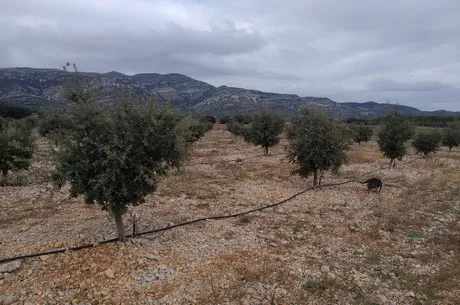“Truffles are currently grown and purchased from different markets and producers in order to supply all customers. This product is consumed in the US, Japan, the United Arab Emirates, etc. There are plantations even in Australia and Argentina which yield positive results, especially in the former. This helps extend the campaign, which is not always positive, as it is a seasonal product that is not in demand all year round,” says Daniel Puig Roca, manager of Trufas del Maestrazgo.
According to Daniel, Spain is the world's largest producer. “Even countries with a truffle growing tradition, like France, are surprised with the volume supplied by Spanish regions such as the Maestrazgo and the Sureste (Soria, Castellón, Guadalajara, Teruel, Cuenca), which have the ideal soil and weather. The main importer of Spanish truffles is still France, which in turn exports it to various destinations, sometimes as Périgord truffles. Italy also imports Spanish truffles for both national consumption and export,” he says.
Waiting list in nurseries
“There is currently a truffle boom. A lot has been planted and its cultivation continues to expand. But if a good field is not available or adequate work is done, the production will be affected. Other fungi will proliferate, or it will grow unscented, etc. It is a crop that requires very good care," says Daniel Puig.
"In the case of the wild ones, dirty and abandoned mountains are not suitable for their growth. With the passing of herds, the forest used to be cleaned and fertilized, and the weeds and grass were kept under control," he says. "Coal and firewood used to be collected as fuel in the past and thus the mountain was cleaned. If this doesn't happen, the truffle won't develop.”
The result is that only 1% of truffles nowadays are wild. In contrast, the nurseries offering mycorrhized trees have waiting lists of up to two years. To grow truffles, a tree (holm oak, kermes oak, oak...) is taken and mycorrhized with the fungus placed in contact with the roots. After 6-7 years, truffles begin to grow. The peak in terms of yield is reached after between 12 and 20 years.
Without adequate soil it is impossible to grow truffles. Another factor is climate change, which can lead to lack of irrigation. You also need peat to facilitate a good development and substrate as fertilizer," says Daniel.

The four requirements to obtain quality truffles:
- Adequate soil
- Care for the plantation
- Enough irrigation (wells)
- Use of substrate
If these requirements are not met, the truffle will be of poor quality and the production falls. The different classes are:
- Extra, spherical and with a great aroma;
- First class, with aroma, but not fully round;
- Second class, with aroma, but with angles and imperfections;
- Third class, which may have holes, be soft, and rot.

The truffle boom is not only due to prices. “Truffles are not an expensive product, as they are only consumed in small quantities. It is a condiment and not an ingredient. If it falls below € 250 / kg, the production costs won't be covered. It is a crop that requires demanding care,” says Daniel.
"The post-harvest is tricky. The cold chain cannot be broken and the product has a shelf life of about 15 days. This will actually be shortened due to price speculation. Some marketers keep it in storage for a week hoping prices will rise," he says.
Chinese truffle has no aroma
The problem with the competition from Chinese truffle (the Tuber indicum variety) is that, in terms of appearance, it is identical to the European one. However, when it comes to taste and aroma, it does not meet the same basic standards as the Tuber melanosporum, the Spanish black truffle, or the Périgord. Since the market is swayed by looks, the client ends up consuming an insipid and odorless truffle.
Luckily, the gourmet truffle has its clientele, even without a perfect shape. “A truffle not being visually perfect doesn't prevent the aroma and taste from being optimal for haute cuisine, where it is used scraped, crushed, etc. It is also used in preserves, sausages, cheese, etc.”

The substrate determines the truffle
“The substrate is a basic element in truffle cultivation to ensure that it grows with a round shape and a good aroma. Holm oak roots with truffle spores are planted in 20-30 cm of substrate and 20 cm of peat. It is important for the soil to have a pH of 7.5-8, a loose texture that allows the truffle to become spherical and a low level of phosphorus, but high of potassium, so that the product can withstand droughts and cold temperatures and grow to a good size,” says Óscar Guido, of Costiña Orgánica.

To make it easier for the truffles to grow with uniform and spherical shapes, padding the soil to reduce its compaction, reducing its mineral fraction and improving its retention and oxygenation have shown to be effective measures. A good substrate is vital to achieve this. According to Oscar, it is important for them to be free of fungi, pathogens and weeds.
"The Tubermax® substrates undergo sterilization at between 75 ºC and 80 ºC," he says. "Also, the combination of granulated and micronized clays and hydrogels enhances the water retention, which is an important parameter for the success of truffle cultivation," says Oscar Guido.

Trufas del Maestrazgo de Catí was created in 2013, but had been in the sector for years, and cultivates and markets fresh truffles.
Costiña organic S.L. is a company with more than 15 years of experience in the manufacture of substrates and the provision of technical advice. It has extensive experience in the cultivation of black truffles.
For more information:
Óscar Guido García
Costiña Orgánica
Ctra.N634 km707,5
O Pino, A Coruña. Spain
+34 981518704
[email protected]
www.costinaorganica.es
Daniel Puig Roca
Trufas del Maestrazgo
+34 600702655
[email protected]
